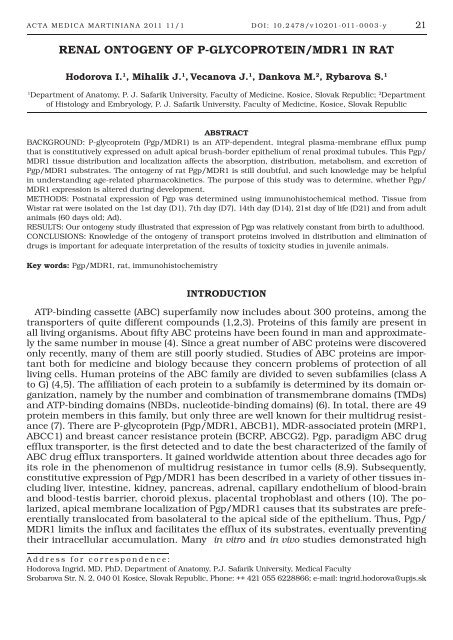Acta Medica Martiniana - Univerzita Komenského
Acta Medica Martiniana - Univerzita Komenského
Acta Medica Martiniana - Univerzita Komenského
Create successful ePaper yourself
Turn your PDF publications into a flip-book with our unique Google optimized e-Paper software.
ACTA MEDICA MARTINIANA 2011 11/1<br />
DOI: 10.2478/v10201-011-0003-y<br />
21<br />
REnAL OntOGEnY OF P-GLYCOPROtEIn/MDR1 In RAt<br />
Hodorova I. 1 , Mihalik J. 1 , Vecanova J. 1 , Dankova M. 2 , Rybarova S. 1<br />
1<br />
Department of Anatomy, P. J. Safarik University, Faculty of Medicine, Kosice, Slovak Republic; 2 Department<br />
of Histology and Embryology, P. J. Safarik University, Faculty of Medicine, Kosice, Slovak Republic<br />
ABStRACt<br />
BACKGROUND: P-glycoprotein (Pgp/MDR1) is an ATP-dependent, integral plasma-membrane efflux pump<br />
that is constitutively expressed on adult apical brush-border epithelium of renal proximal tubules. This Pgp/<br />
MDR1 tissue distribution and localization affects the absorption, distribution, metabolism, and excretion of<br />
Pgp/MDR1 substrates. The ontogeny of rat Pgp/MDR1 is still doubtful, and such knowledge may be helpful<br />
in understanding age-related pharmacokinetics. The purpose of this study was to determine, whether Pgp/<br />
MDR1 expression is altered during development.<br />
METHODS: Postnatal expression of Pgp was determined using immunohistochemical method. Tissue from<br />
Wistar rat were isolated on the 1st day (D1), 7th day (D7), 14th day (D14), 21st day of life (D21) and from adult<br />
animals (60 days old; Ad).<br />
RESULTS: Our ontogeny study illustrated that expression of Pgp was relatively constant from birth to adulthood.<br />
CONCLUSIONS: Knowledge of the ontogeny of transport proteins involved in distribution and elimination of<br />
drugs is important for adequate interpretation of the results of toxicity studies in juvenile animals.<br />
Key words: Pgp/MDR1, rat, immunohistochemistry<br />
IntRODUCtIOn<br />
ATP-binding cassette (ABC) superfamily now includes about 300 proteins, among the<br />
transporters of quite different compounds (1,2,3). Proteins of this family are present in<br />
all living organisms. About fifty ABC proteins have been found in man and approximately<br />
the same number in mouse (4). Since a great number of ABC proteins were discovered<br />
only recently, many of them are still poorly studied. Studies of ABC proteins are important<br />
both for medicine and biology because they concern problems of protection of all<br />
living cells. Human proteins of the ABC family are divided to seven subfamilies (class A<br />
to G) (4,5). The affiliation of each protein to a subfamily is determined by its domain organization,<br />
namely by the number and combination of transmembrane domains (TMDs)<br />
and ATP-binding domains (NBDs, nucleotide-binding domains) (6). In total, there are 49<br />
protein members in this family, but only three are well known for their multidrug resistance<br />
(7). There are P-glycoprotein (Pgp/MDR1, ABCB1), MDR-associated protein (MRP1,<br />
ABCC1) and breast cancer resistance protein (BCRP, ABCG2). Pgp, paradigm ABC drug<br />
efflux transporter, is the first detected and to date the best characterized of the family of<br />
ABC drug efflux transporters. It gained worldwide attention about three decades ago for<br />
its role in the phenomenon of multidrug resistance in tumor cells (8,9). Subsequently,<br />
constitutive expression of Pgp/MDR1 has been described in a variety of other tissues including<br />
liver, intestine, kidney, pancreas, adrenal, capillary endothelium of blood-brain<br />
and blood-testis barrier, choroid plexus, placental trophoblast and others (10). The polarized,<br />
apical membrane localization of Pgp/MDR1 causes that its substrates are prefeerentially<br />
translocated from basolateral to the apical side of the epithelium. Thus, Pgp/<br />
MDR1 limits the influx and facilitates the efflux of its substrates, eventually preventing<br />
their intracellular accumulation. Many in vitro and in vivo studies demonstrated high<br />
Address for correspondence:<br />
Hodorova Ingrid, MD, PhD, Department of Anatomy, P.J. Safarik University, <strong>Medica</strong>l Faculty<br />
Srobarova Str. N. 2, 040 01 Kosice, Slovak Republic, Phone: ++ 421 055 6228866; e-mail: ingrid.hodorova@upjs.sk

















